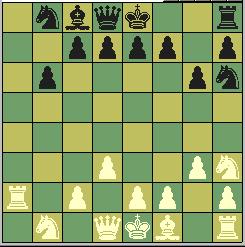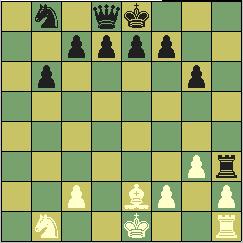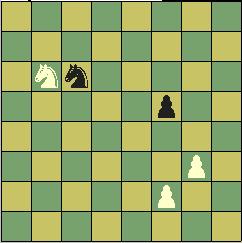
Fredrik Sandström - Fabrice Liardet,
Losing Chess World Championship
Utrecht, 2001
1.g3 The reputation of this opening move is to lead to a theory-free and quiet game. The former is true - it certainly got a lot less interest than 1.e3 from opening analysts - but in my opinion the latter is not if White plays aggressively, like in this game. 1...g6 Assuming that playing symmetry is always safe. Actually, the modern 1...c5 may be a harder test of the g3 opening. 2.b4 As usual avoiding theoretical paths, Fredrik varies slightly from the usual 2.b3. This gives Black some more options, none of which being that interesting though. 2...b6 3.Nh3! The old belief that there was nothing to do for White in this position does not hold: the idea Ng5xh7, aiming for the h6 weakness, is much more dangerous than it looks like. For example after the often played 3...d6 , 4.Ng5! Bh3? 5.Nxh7 Rxh7 6.Bxh3 Rxh3 7.e4! Rxh2 8.Rxh2 , Black is just dead on the h6 square. However, 4...h5!? 5.Nxf7 Kxf7 6.Bh3 Bxh3 7.Rf1 Bxf1 8.Kxf1 Nh6! still looks about OK for Black. But I was looking for something safer: 3...a5 4.bxa5 Rxa5 The idea is to play 5...Rxa2 6.Rxa2 Ba6, now that there is no more white b-pawn. 5.d3! After 5.Ba3 Rxa3 6.Nxa3, Black can create mayhem by 6...b5 7.Nxb5 Bg7!? 8.Nxc7 Bxa1 9.Qxa1 Qxc7, but also play the quiet 6...Bh6 (as it was of course intended) 5...Rxa2 6. Rxa2 Bh6?! A very risky choice, the normal move being the evident 6...Ba6 7.Rxa6 Nxa6, after which Black is safe and the position is probably equal: 8.Ng5 (8.Bh6 Bxh6!) 8...Bh6 [safest, but 8...Qa8 and 8...h5!? are also possible] 9.Nxh7 Rxh7 10.Bxh6 Rxh6 11.Bh3 Rxh3 12.e4 Rxh2 13.Rxh2 Nh6 14.Rxh6 f6 15.Rxg6 f5 16.Rxb6 fxe4 17.dxe4 cxb6 18.Qxd7 Kxd7 with an ending which is difficult to assess. The text move intends to lure White into tempting possibilities to get an active position at the price of a few pawns. The analysis seems to show that I have been somewhat overconfident in the power of my pawn mass. 7. Bxh6 Nxh6

Although the lines are quite tricky, White has an excellent tactical possibility here by 8.g4! Nxg4 9.Ng5 Nxf2 [Alas, the computer didn't like 9...Nxh2? 10.Nxh7 Nxf1 11.Rxf1 Rxh7 12.Ra5! bxa5 13.Rh1 Rxh1 14.Qd2 Rxe1 15.Qxa5 Rxe2 16.Qxc7 or 10...Rxh7 11.Rxh2 Rxh2 12.Bg2 Rxg2 13.Kd2 Rxf2 14.Qh1! Rxe2 15.Kxe2 Bb7 16.Qxb7 Na6 17.Rxa6!] 10.Nxh7 Rxh7 11.Kxf2 Rxh2 12.Rxh2 Ba6 [12...c5 13.Rh5 gxh5 14.d4! cxd4 15.Qxd4 Qc7 16.Qxd7 and White wins the queen battle] 13.Rxa6 Nxa6 14.Qe1! Nb4 (only) 15.Qxb4 d6 16.Qxb6 cxb6 17.Bh3!

(analysis) after which Black still has a nice pawn phalanx but will be left with a lone king, and White should win. Let us go back to the game:

8.Ra6?! However tempting, this is the wrong way. 8...Bxa6! Aiming the elimination of the White pawns, after which the black pawns should give White a hard time. After 8...Nxa6, 9.e3? Ng4 10.Qxg4 c5! is too dangerous; 9.g4!? still leads to tricky lines although Black seem to do better in these ones than in the 8.g4! variation. 9.Qc1! Going for the refutation; 9.Ng5 Bxd3 10.Qxd3 Ng4 and 10.Nxh7 Rxh7 11.Qxd3 Rg7! both seem fine for Black. 9...Bxd3 10.Qxh6 Bxe2 11.Qxh7 Less appealing though playable was 11.Bxe2 g5! 12.Nxg5 Rf8 13.Nxf7 Kxf7 14.Qxf8 Qxf8 15.Ba6 Nxa6 and Blacks stands slightly better. 11...Rxh7 12.Bxe2 Rxh3 Up to this move, all was more or less forced for both sides.
Not any good is now 13.Bc4? Rxh2 14.Rxh2 e5!
15.Bxf7 Kxf7 16.Rh4 [better 16.Rh5 gxh5 17.Nd2] 16...Qxh4
17.gxh4 c5! and the White knight is imprisoned by the black
pawns.
The text move is about OK, but best was the safe 13.Ba6 Nxa6
14.Nd2! [14.c4?! Rxh2 15.Rxh2 e5! and the knight is in trouble
again] 14...Rxh2 15.Rxh2 c5 16.Nf1, just escaping the Black
steamroll.
(analysis) As White is now threatening a simple win starting by 17.Rh5, Black has to give the queen: 17...Qc7 18.c4!? [18.Ke2 Qxg3 19.fxg3 c4 gains space for Black] 18...Qxg3 19.fxg3 e5 and if Black survives immediate threats he will stand better, as it is hard for White to keep his rook after Black plays the king to the g-file. However, I may be somewhat biased in favor of the pawns against the pieces, as I often am (the game demonstrated it too!). Back to the move actually played now:

13.Bf3?! An excellent placement for the bishop, slowing down Black's development, but at the price of one valuable tempo. 13...Rxh2 14. Rxh2 c5! This is the pawn which is going to win the game, and avoiding it being blocked by 15.Bc6 is here even more important than keeping the king. 15.Bc6?! 15.Ke2 is more subtle, because 15...c4? loses to 16.Kd3!! cxd3 17.cxd3 followed by 18.Bc6 and 15...d6?! allows 16.Bc6 Nxc6 17.Nd2! However, 15...e5! keeps White boxed in. Other moves fail to address the positional threat of 15...c4, followed by 16...d6. 15...Nxc6 16.Rh8?! Who wouldn't have played this move? But although the king is the most powerful piece in Losing Chess, checkmate does not necessarily mean a win, and here it is in fact just losing! It is nevertheless already very hard for White to do anything against Black slowly reinforcing his position by c5-c4, Ke8-f8-g7, as for instance 16.c4? loses to 16...d6! [the simple threat of 17...b5 18.cxb5 Kf8 19.bxc6 Qd7 20.cxd7 Ke8 is too strong], and 16.f4 does not carry any threat.
Black to play and win!
There is no way to save the king, but the impressive black pawn mass is just about to get in action: 16...c4! 17.Rxe8 Qxe8 18.Kd2 Forced: 18.c3 loses simply to 18...Nb4 19.cxb4 c3 20.Nxc3 d5 21.Nxd5 e6 etc. Now the win comes from a typical shot: 18...Qh8! Trivial and bad would be the king recapture 18...c3?? 19.Kxc3 Nd4 20.Kxd4 d5 21.Kxd5 e6? 22.Kxe6 fxe6 23.f4! b5 (Zugzwang) 24.Nd2! and Black loses. The queen is clearly worse than the knight in such endings with a few pawns for each camp.
The threat is now 19...Qc3
with an immediate win and there is only one way to avoid it. 19.Kd3 cxd3 20.cxd3
Qc3 21.Nxc3
How to win now? At first sight it looks like Black only has the
choice between several knight endings and pawn endings, all of
which are very complicated. Nevertheless, two of them are much
less complicated than the others: 21...d5 The other (less elegant) option was the similar
pawn ending 21...b5 22.Nxb5 Nd4 23.Nxd4 f5 24.Nxf5 gxf5 25.g4
fxg4 26.f3 gxf3 27.d4 e5 28.dxe5 d6 29.exd6 f2 30.d7 f1R and
wins. 22.Nxd5 e5! 23.Nxb6 e4 24.dxe4
f5 25.exf5 gxf5

The win is much simpler than it seems:
disregarding the pawns, the black knight will dominate the white
one on the next move, as in a classical N v N ending. That means
that White is forced to give both of his pawns. Then the white
knight will still be dominated and will have to take the black
one. The ending with N versus f-pawn loses unless the knight can
sacrifice itself to the pawn on e1 (knight playing on the pawn's
colour) or come to f3/g4 (N playing on the other colour; then
bishop promotion fails to Nh2!). It is easily checked that in the
present position this is impossible.
26.g4 fxg4 27.Na4 After 27.f3 gxf3
28.Nc4/Nd7, Black must of course just avoid 28...Ne5??? 29.Nxe5
f2 30.Nf3! and give away the knight on the other available
square. 27...Nb4! 28.f3 gxf3 29.Nc3 Na2
30.Nxa2 f2 31.Nc3 f1=N and White
resigned: 0-1.